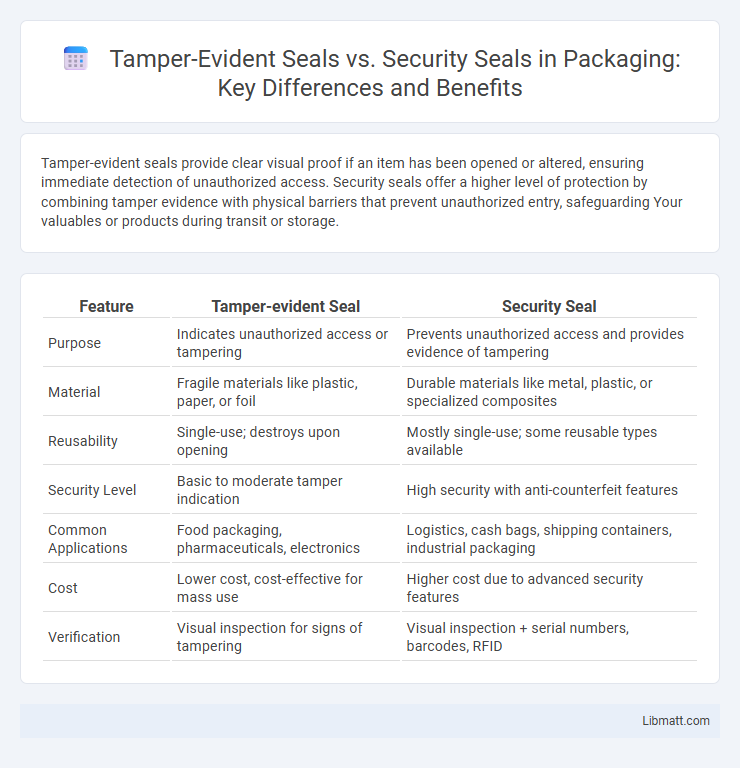Tamper-evident seals provide clear visual proof if an item has been opened or altered, ensuring immediate detection of unauthorized access. Security seals offer a higher level of protection by combining tamper evidence with physical barriers that prevent unauthorized entry, safeguarding Your valuables or products during transit or storage.
Table of Comparison
| Feature | Tamper-evident Seal | Security Seal |
|---|---|---|
| Purpose | Indicates unauthorized access or tampering | Prevents unauthorized access and provides evidence of tampering |
| Material | Fragile materials like plastic, paper, or foil | Durable materials like metal, plastic, or specialized composites |
| Reusability | Single-use; destroys upon opening | Mostly single-use; some reusable types available |
| Security Level | Basic to moderate tamper indication | High security with anti-counterfeit features |
| Common Applications | Food packaging, pharmaceuticals, electronics | Logistics, cash bags, shipping containers, industrial packaging |
| Cost | Lower cost, cost-effective for mass use | Higher cost due to advanced security features |
| Verification | Visual inspection for signs of tampering | Visual inspection + serial numbers, barcodes, RFID |
Understanding Tamper-Evident Seals
Tamper-evident seals provide a clear visual indication if a product or container has been opened or altered, ensuring product integrity and consumer safety. These seals often incorporate unique designs or materials that cannot be removed without leaving obvious damage or traces, making unauthorized access easily detectable. In contrast, security seals may focus on physical deterrence but do not always guarantee visible evidence of tampering.
What Are Security Seals?
Security seals are tamper-evident devices designed to protect products, containers, and equipment by providing visual evidence of unauthorized access or tampering. They come in various forms such as plastic, metal, or adhesive seals, each engineered to break or show damage when tampered with, ensuring the integrity of the sealed item. These seals are widely used in industries like logistics, pharmaceuticals, and food safety to safeguard shipments, secure storage, and comply with regulatory requirements.
Key Differences Between Tamper-Evident and Security Seals
Tamper-evident seals are designed to provide visual proof if an item has been opened or altered, making unauthorized access immediately noticeable. Security seals offer broader protection by deterring tampering and unauthorized entry, often incorporating unique serial numbers or barcodes for tracking. Understanding these key differences helps you choose the right seal for enhancing your asset protection and ensuring tamper detection.
Use Cases: When to Choose Tamper-Evident Seals
Tamper-evident seals are ideal for packaging pharmaceuticals, food products, and electronics where visible evidence of unauthorized access is critical for safety and compliance. Choose tamper-evident seals when you need to ensure product integrity during shipping and storage, providing customers and regulators with confidence that items remain untouched. Your choice should prioritize tamper-evident seals whenever clear, irreversible proof of tampering is essential to protect brand reputation and consumer trust.
Applications of Security Seals Across Industries
Security seals are widely used across industries such as logistics, healthcare, food and beverage, and pharmaceuticals to prevent tampering and ensure product integrity during transportation and storage. These seals provide visible evidence of unauthorized access, making them essential for securing containers, packages, and equipment in critical supply chains. In sectors like aviation and retail, security seals also help maintain regulatory compliance and protect against theft or contamination.
Materials and Technologies Used in Seals
Tamper-evident seals primarily use materials such as vinyl, polyester, and foil combined with technologies like adhesive overlays and destructive fibers to ensure visible evidence of interference. Security seals often incorporate stronger materials, including metal, plastic, and cable, integrated with advanced technologies such as serialized barcodes, RFID chips, and holographic images to enhance authentication and tracking. Your choice between tamper-evident and security seals should consider the level of protection and technological features required for your application.
Advantages and Limitations of Each Seal Type
Tamper-evident seals provide clear visual indicators of unauthorized access, enhancing security by deterring tampering and ensuring product integrity, but they may be less durable under harsh conditions. Security seals offer robust physical protection with strong materials and custom locking mechanisms, ideal for high-risk scenarios, yet they often require specialized tools for removal and may not always provide immediate visual evidence of tampering. Choosing between tamper-evident and security seals depends on balancing the need for visible tamper detection with the level of physical security required for the application.
Compliance and Regulatory Standards
Tamper-evident seals are designed to show clear signs of interference, meeting strict compliance and regulatory standards required in pharmaceuticals, food packaging, and electronics industries to ensure product integrity. Security seals, often utilized in transportation and logistics, comply with global regulations such as ISO 17712 to provide evidence of unauthorized access or tampering during transit. Both seals play crucial roles in adhering to industry-specific guidelines that prevent contamination, theft, and fraud, thereby enhancing consumer safety and trust.
Choosing the Right Seal for Your Needs
Tamper-evident seals provide clear visual evidence of unauthorized access, making them ideal for monitoring package integrity and deterring theft. Security seals offer a higher level of protection with robust materials and unique locking mechanisms suitable for high-value or sensitive shipments. Choosing the right seal depends on your specific security requirements, item value, and the level of tamper detection needed.
Future Trends in Tamper-Evident and Security Seal Technology
Emerging trends in tamper-evident and security seal technology emphasize integration with smart sensors and blockchain for enhanced authenticity verification and real-time tampering alerts. Advances in materials science are driving the development of biodegradable and ultra-durable seals, responding to both environmental concerns and security demands. The adoption of IoT-enabled seals facilitates continuous monitoring and data collection across supply chains, significantly improving anti-counterfeiting measures and regulatory compliance.
Tamper-evident seal vs security seal Infographic

 libmatt.com
libmatt.com